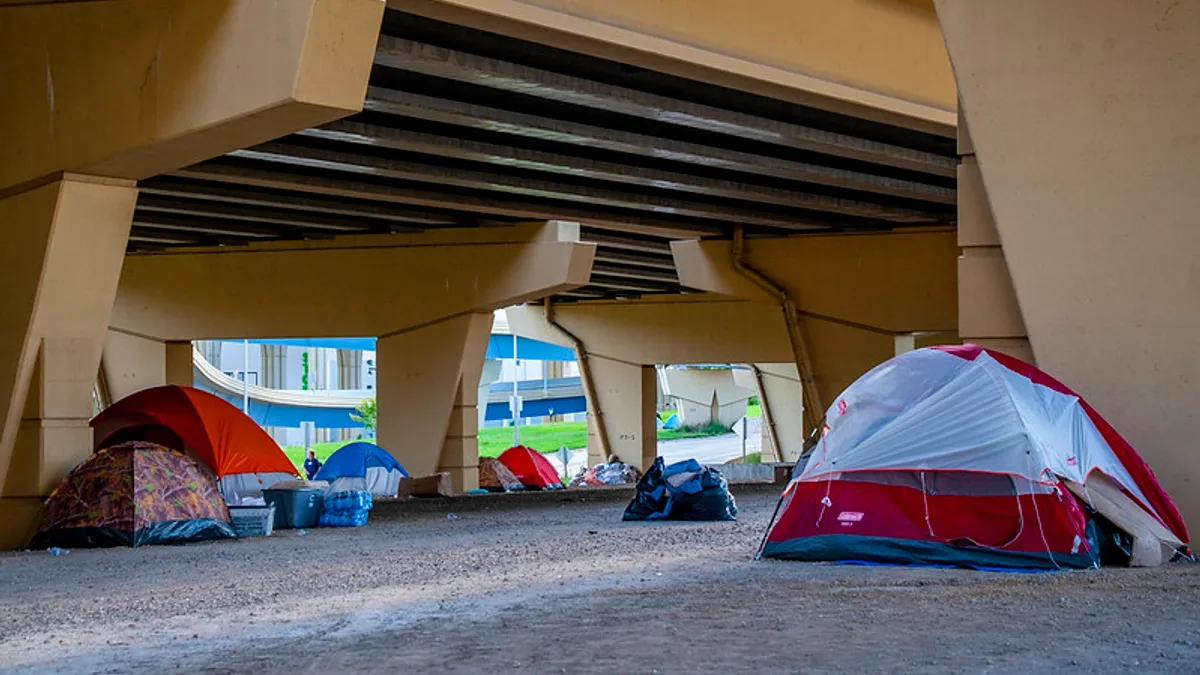The novel coronavirus pandemic (COVID-19) has shown a disproportionate effect on homeless groups, a challenge that leaders anticipate will only get worse as renters face evictions and economic turmoil threatens to result in an additional 1.5 million "extremely low-income" households.
In a virtual town hall hosted by the National Alliance to End Homelessness on Wednesday, public and private sector stakeholders gathered to discuss the state of U.S. homelessness and how their cities or organizations are working to support populations like the unsheltered, formerly incarcerated, and those facing eviction.
Housing the unsheltered
At the onset of the pandemic, many cities scrambled to temporarily house the unsheltered, who represent about 37% of the overall homeless population. The Connecticut Department of Housing (CTDOH) was one such group that worked to identify individuals over the age of 60 and place them in hotels using state funds, said Steve DiLella, director of individual and family support at CTDOH, on the town hall meeting.
Similar initiatives to utilize vacant hotels for the shelter of individuals experiencing homelessness occurred in Los Angeles and New York, among other major cities, to varying degrees of success.
CTDOH also teamed up with the state's Department of Health to minimize the COVID-19 spread within homeless shelters by creating an executive order stating that non-congregate shelters (like hotels) were the best option for homeless groups. Ultimately, they contracted up to 13 hotels for about 850 rooms, which decreased their shelter census by 60%, DiLella said.
These efforts to quickly place individuals in hotels while freeing up space in shelters resulted in an "extremely low" rate of positive COVID-19 cases among Connecticut's homeless population, he said.
The prison-to-homelesness pipeline
Formerly incarcerated people are nearly 10 times more likely to experience homelessness than the general population, according to a Prison Policy Initiative report. In New York City alone, over 54% of individuals who are released from prison move directly into the shelter system.
Criminalized people live in a perpetual state of insecurity, Lucius Couloute, sociologist and assistant professor at Suffolk University, said in the virtual event. That vulnerability could be particularly dangerous as people experiencing homelessness are twice as likely to be hospitalized due to COVID-19, and three times as likely to die from COVID-19 compared to the general population.
He recommended the following policy-based initiatives to end the prison-to-homelessness pipeline:
-
Stop relying on over-policing and over-incarcerating
-
"Ban the box" on housing applications: A criminal record is not a good proxy for someone's suitability as a tenant, and "banning the box" on applications would help level the playing field, he said.
-
Implement automatic criminal record expungement procedures: "When folks are convicted of a crime and sentenced, rarely are they sentenced to periods of housing insecurity or homelessness. But the fact remains that folks with criminal records often experience as a collateral consequence, homelessness and housing insecurity," he said.
The 'looming eviction crisis'
Prior to the pandemic, there were about 3.7 million evictions per year in America on average, or seven evictions filed every single minute, Matthew Desmond, sociologist and assistant professor at Princeton University, said on the webinar. Now, individuals struggle to make a steady income amid the pandemic, city leaders and housing advocates are bracing for a potential "tidal wave of evictions" and homelessness.
"Eviction is not a solution, it’s a problem," Desmond said. "An eviction causes a blemish or mark on your record that can drive you into worse neighborhoods or worse housing ... It’s been linked to job loss and depression. Eviction isn’t just a condition of poverty, it’s a cause of poverty and a cause of homelessness."
Desmond suggested that states respond to the "looming eviction crisis" by increasing the length of moratoriums; installing mediation courts between tenants and landlords; and advocating for rent relief.











